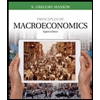Assume an economy with a coal producer, a steel producer, and some consumers. (There is no government.) In a given year, the coal producer produces 15 million tonnes of coal and sells it for $5 per tonne. The coal producer pays $60 million in wages to consumers. The steel producer uses 40 million tonnes of coal as an input into steel production, all purchased at $5 per tonne. Of this, 15 million tonnes of coal comes from the domestic coal producer, and 25 million tonnes is imported. The steel producer produces 19 million tonnes of steel and sells it for $15 per tonne. Domestic consumers buy 11 million tonnes of steel, and 8 million tonnes are exported The steel producer pays consumers $70 million in wages. All profits made by domestic producers are distributed to domestic consumers. a. Determine GDP using (i) the product approach, (i) the expenditure approach, and (iii) the income approach. () Using the product approach, the value added by the coal producer is $million, the value added by the steel producer is $million, and GDP in this economy is million.
Assume an economy with a coal producer, a steel producer, and some consumers. (There is no government.) In a given year, the coal producer produces 15 million tonnes of coal and sells it for $5 per tonne. The coal producer pays $60 million in wages to consumers. The steel producer uses 40 million tonnes of coal as an input into steel production, all purchased at $5 per tonne. Of this, 15 million tonnes of coal comes from the domestic coal producer, and 25 million tonnes is imported. The steel producer produces 19 million tonnes of steel and sells it for $15 per tonne. Domestic consumers buy 11 million tonnes of steel, and 8 million tonnes are exported The steel producer pays consumers $70 million in wages. All profits made by domestic producers are distributed to domestic consumers. a. Determine GDP using (i) the product approach, (i) the expenditure approach, and (iii) the income approach. () Using the product approach, the value added by the coal producer is $million, the value added by the steel producer is $million, and GDP in this economy is million.
Essentials of Economics (MindTap Course List)
8th Edition
ISBN:9781337091992
Author:N. Gregory Mankiw
Publisher:N. Gregory Mankiw
Chapter17: Production And Growth
Section: Chapter Questions
Problem 5CQQ
Related questions
Question

Transcribed Image Text:Assume an economy with a coal producer, a steel producer, and some consumers. (There is no government.) In a given year, the coal producer produces 15 million
tonnes of coal and sells it for $5 per tonne. The coal producer pays $60 million in wages to consumers. The steel producer uses 40 million tonnes of coal as an input
into steel production, all purchased at $5 per tonne. Of this, 15 million tonnes of coal comes from the domestic coal producer, and 25 million tonnes is imported. The
steel producer produces 19 million tonnes of steel and sells it for $15 per tonne. Domestic consumers buy 11 million tonnes of steel, and 8 million tonnes are exported.
The steel producer pays consumers $70 million in wages. All profits made by domestic producers are distributed to domestic consumers.
a. Determine GDP using (i) the product approach, (ii) the expenditure approach, and (ii) the income approach.
(1) Using the product approach, the value added by the coal producer is $million, the value added by the steel producer is $ million, and GDP in this economy is
$4
million.
Expert Solution
This question has been solved!
Explore an expertly crafted, step-by-step solution for a thorough understanding of key concepts.
This is a popular solution!
Trending now
This is a popular solution!
Step by step
Solved in 5 steps

Knowledge Booster
Learn more about
Need a deep-dive on the concept behind this application? Look no further. Learn more about this topic, economics and related others by exploring similar questions and additional content below.Recommended textbooks for you

Essentials of Economics (MindTap Course List)
Economics
ISBN:
9781337091992
Author:
N. Gregory Mankiw
Publisher:
Cengage Learning

Brief Principles of Macroeconomics (MindTap Cours…
Economics
ISBN:
9781337091985
Author:
N. Gregory Mankiw
Publisher:
Cengage Learning

Exploring Economics
Economics
ISBN:
9781544336329
Author:
Robert L. Sexton
Publisher:
SAGE Publications, Inc

Essentials of Economics (MindTap Course List)
Economics
ISBN:
9781337091992
Author:
N. Gregory Mankiw
Publisher:
Cengage Learning

Brief Principles of Macroeconomics (MindTap Cours…
Economics
ISBN:
9781337091985
Author:
N. Gregory Mankiw
Publisher:
Cengage Learning

Exploring Economics
Economics
ISBN:
9781544336329
Author:
Robert L. Sexton
Publisher:
SAGE Publications, Inc

Principles of Economics 2e
Economics
ISBN:
9781947172364
Author:
Steven A. Greenlaw; David Shapiro
Publisher:
OpenStax

Principles of Economics (MindTap Course List)
Economics
ISBN:
9781305585126
Author:
N. Gregory Mankiw
Publisher:
Cengage Learning

Principles of Macroeconomics (MindTap Course List)
Economics
ISBN:
9781305971509
Author:
N. Gregory Mankiw
Publisher:
Cengage Learning